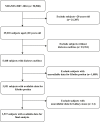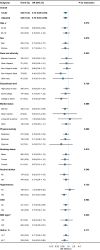Association between Serum Klotho and Kidney Stones in US Middle-Aged and Older Individuals with Diabetes Mellitus: Results from 2007 to 2016 National Health and Nutrition Survey
- PMID: 37231844
- PMCID: PMC10614277
- DOI: 10.1159/000531045
Association between Serum Klotho and Kidney Stones in US Middle-Aged and Older Individuals with Diabetes Mellitus: Results from 2007 to 2016 National Health and Nutrition Survey
Abstract
Introduction: Kidney stones (KSs) are associated with hematuria and renal failure and pose a significant clinical and public health concern. Diabetes is associated with a higher risk of KSs. In addition, α-Klotho (Klotho), as a novel antiaging protein, is associated with kidney disease, diabetes, and complications and may participate in the pathological mechanism of KSs. However, studies that used large population-based database research are limited. Therefore, this study aimed to investigate whether or not KS prevalence is associated with serum Klotho levels in diabetic adults in the USA.
Methods: This nationally representative cross-sectional study used data on diabetic adults in the USA aged 40-79 years from the National Health and Nutrition Examination Survey 2007-2016 cycles. Multivariate logistic regression models were used to calculate the association between Klotho and KS. Restricted cubic splines were used to further test for linearity and explore the shape of the dose-response association. Moreover, we performed stratified and interaction analyses to see if the relationship was stable in different subgroups.
Results: Among the 3,537 diabetic patients included in this study (mean age of 61.4 years, consisting of 51.3% males), 543 participants (15.4%) suffered from KS. In the fully adjusted model, Klotho was negatively associated with KS (OR = 0.72; 95% CI: 0.54-0.96; p = 0.027). A negative relationship was observed between the occurrence of KS and Klotho (nonlinear: p = 0.560). Some differences in the association between Klotho and KS were found in stratified analyses; however, these differences lacked statistical significance.
Conclusions: Serum Klotho was negatively associated with the incidence of KS; when ln-transformed Klotho concentration increased by 1 unit, the risk of KS was 28% lower.
Keywords: Diabetes mellitus; Kidney stones; National Health and Nutrition Survey; α-Klotho (Klotho).
© 2023 The Author(s). Published by S. Karger AG, Basel.
Conflict of interest statement
The remaining authors declare that they have no conflict of interest.
Figures


Similar articles
-
The association between serum soluble Klotho and chronic kidney disease among us adults ages 40 to 79 years: Cross-sectional study.Front Public Health. 2022 Oct 6;10:995314. doi: 10.3389/fpubh.2022.995314. eCollection 2022. Front Public Health. 2022. PMID: 36276390 Free PMC article.
-
Association Between Serum α-Klotho Levels and Diabetic Kidney Disease Prevalence in Middle-Aged and Elderly US Patients with Diabetes: A Cross-Sectional Study Using NHANES 2007-2016 Data.Diabetes Ther. 2025 Mar;16(3):499-511. doi: 10.1007/s13300-024-01683-7. Epub 2025 Feb 10. Diabetes Ther. 2025. PMID: 39928222 Free PMC article.
-
Association between frailty with kidney stones disease among adults aged 20 years and older population: a cross-sectional study of NHANES 2007-2020.Eur J Med Res. 2025 May 24;30(1):412. doi: 10.1186/s40001-025-02672-7. Eur J Med Res. 2025. PMID: 40410858 Free PMC article.
-
Associations between the TyG index and the ɑ-Klotho protein in middle-aged and older population relevant to diabetes mellitus in NHANES 2007-2016.Lipids Health Dis. 2024 Jun 21;23(1):188. doi: 10.1186/s12944-024-02172-3. Lipids Health Dis. 2024. PMID: 38907289 Free PMC article.
-
Association between serum Klotho levels and the prevalence of diabetes among adults in the United States.Front Endocrinol (Lausanne). 2022 Nov 9;13:1005553. doi: 10.3389/fendo.2022.1005553. eCollection 2022. Front Endocrinol (Lausanne). 2022. PMID: 36440221 Free PMC article.
Cited by
-
The association between adult asthma in the United States and dietary total energy intake: a retrospective cross-sectional analysis from NHANES.BMC Nutr. 2024 Sep 27;10(1):128. doi: 10.1186/s40795-024-00938-7. BMC Nutr. 2024. PMID: 39334497 Free PMC article.
-
Inverse association between serum klotho levels and C-reactive protein levels in the US population: a cross-sectional study.BMC Cardiovasc Disord. 2024 Nov 29;24(1):687. doi: 10.1186/s12872-024-04375-z. BMC Cardiovasc Disord. 2024. PMID: 39614159 Free PMC article.
-
Causal associations of inflammatory cytokines and urinary stones: a two-sample Mendelian randomization study.Transl Androl Urol. 2025 Feb 28;14(2):258-265. doi: 10.21037/tau-24-445. Epub 2025 Feb 25. Transl Androl Urol. 2025. PMID: 40114831 Free PMC article.
-
Nonlinear relationship between serum Klotho and chronic kidney disease in US adults with metabolic syndrome.Front Endocrinol (Lausanne). 2024 Dec 24;15:1409560. doi: 10.3389/fendo.2024.1409560. eCollection 2024. Front Endocrinol (Lausanne). 2024. PMID: 39777219 Free PMC article.
-
Sleep patterns and cardiovascular disease risk in US participants: a comprehensive analysis.Front Neurosci. 2025 Jan 9;18:1447543. doi: 10.3389/fnins.2024.1447543. eCollection 2024. Front Neurosci. 2025. PMID: 39850623 Free PMC article.
References
MeSH terms
Substances
LinkOut - more resources
Full Text Sources
Medical

